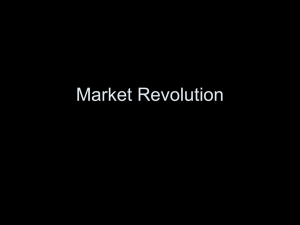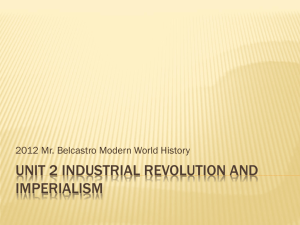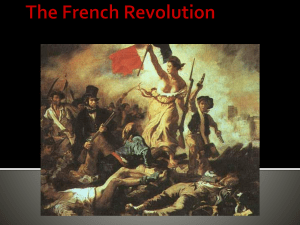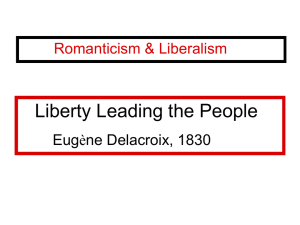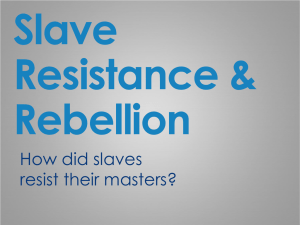AP 22 Market Revolutionx
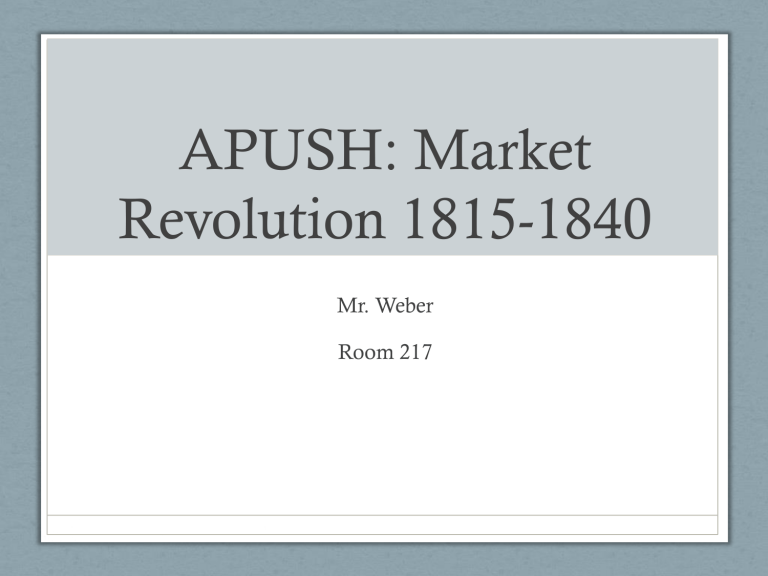
APUSH: Market
Revolution 1815-1840
Mr. Weber
Room 217
Activator
• Chapter 9 reading test: 15 minutes
• 1. What were the major social effects of the market revolution?
• 2. What revolutionary changes did American slavery undergo during this period?
• 3. What role did immigration play in the market revolution?
• 4. How does the Second Great Awakening relate to the market revolution?
Agenda
• Activator, agenda, and objective (20 minutes)
• Benchmark study strategy: matching game (30 minutes)
• The Market Revolution lecture (30 minutes)
• Teaching each other our DBQs (30 minutes)
• Exit ticket and homework (5 minutes)
Objective
• AP Topic #6. Transformation of the Economy and
Society in Antebellum America
• The transportation revolution and creation of a national market economy
• Beginnings of industrialization and changes in social and class structures
• Immigration and nativist reaction
• Planters, yeoman farmers, and slaves in the cotton
South
Benchmark Review: Matching
• In teams of two.
• Match the key term/event in bold with the appropriate definition or phrase.
• You may use your notes and the book but time is of the essence.
• First team finished will receive extra credit on the exam.
Matching
The Market Revolution
• The New Economy
• Roads and steamboats
• Improvements in transportation lowered costs and linked farmers to markets.
• Improved water transportation most dramatically increased the speed and lowered the expense of commerce.
Transportation and
Communication
• The Erie Canal
• Completed in 1825 and made NYC a major trading port.
• State-funded canal as example for funding for internal improvements.
• Railroads and Telegraphs
• Railroads opened the frontier to settlement
• Telegraph introduced a communication revolution
• Improvements in transportation and communication made possible the rise of the West.
• People traveled in groups to clear land and establish communities.
• Squatters set up farms on unoccupied land.
The Cotton Kingdom
• The market revolution and westward expansion heightened the nation’s sectional divisions.
• Rise of cotton production came with Eli Whitney’s cotton gin.
• The cotton gin revolutionized American slavery.
• Historians estimate that around 1 million slaves were shifted old slave states to deep south between 1800-1860
• Slave trading became organized business.
The Market Society
• Commercial farmers
• The Norwest became a region with an integrated economy of commercial farms and manufacturing cities.
• Farmers grew crops and raised livestock for sale.
• The cities in the East provided credit and a market.
• New technologies:
• Steel plow
• Reaper
The Factory System
• Samuel Slater establishes first factory in 1790
• First large scale factories in 1814 in Waltham, Mass. Then
Lowell, Mass.
• Nature of work shifted from skilled artisan to that of factory worker.
• Mass production of interchangeable parts assembled into standardized products.
• New England textile mills relied primarily on female and child labor.
• South lagged behind the North in terms of factory production.
Growth of Immigration
• Economic expansion fueled demand for labor
• German and Irish settled primarily in Northern cities.
• Reasons for migration (push and pull factors)
• Filled mainly low-wage unskilled jobs
Nativism
• Racist reaction to immigration
• Response to growing Catholic presence (Irish)
• Nativists blamed immigrants for:
• Urban crime
• Political corruption
• Alcohol abuse
• Undercutting wages
Individualism
• Freedom linked to availability of land (Manifest
Destiny)
• National myth and ideology surrounding the “West”
• Transcendentalists responded to competitive materialists individualism of emergent capitalism with idea of self-realization through which individuals remake themselves and their own lives
• Ralph Emerson (“Self-Reliance”)
The Second Great Awakening
• Added religious element to celebration of individual selfimprovement, self-reliance, and self-determination.
• Charles Grandison Finney became a national celebrity for his preaching in upstate N.Y.
• Democratized Christianity
• Promoted doctrine of human free will
• Used opportunities of market revolution to spread their message
Limits of Prosperity
• Opportunities for the “self-made man”
• Jacob Astor and Heratio Alger
• Market revolution produced a new middle class.
• Barred from schools and other public facilities most free African Americans and women were excluded from economic opportunities.
Cult of Domesticity
• New definition of femininity emerged based on values of love, friendship, and mutual obligation
• Virtue became personal moral quality
• Women should find freedom fulfilling their duties in their sphere
Early Labor Movement
• Some felt that the market revolution reduced their freedom
• Economic swings widened gap between rich and poor
• First workingman’s parties est. 1820s
• Strikes were common by the 1830s
• Wage-earners evoked “liberty” when calling for improvements in the workplace
• Some described wage labor as slavery: “wage slaves”
Sharing our DBQs
• Form a reading group and share out your DBQ’s from the “securing the republic,” 1790-1815, period.
• Take notes and ask questions for clarification.
Voices of Freedom
• Pick a quote from Emerson’s “The American
Scholar” and explicate it.
• Pick a second quote from Orestes Brownson’s “The
Laboring Classes” and explicate it.
• Prepare to share your quotes and explanations on
Thursday in class.
Exit ticket and homework
• 1. How was it to read the chapter before hearing lecture about it?
• Homework:
• Explicate 2 quotes from the Voices of Freedom for Thursday.
• Benchmark Thursday.
• Begin reading Chapter 10 on Democracy in America 1815-1840 for next Tuesday.
• Prepare for Friday’s debate on Jacksonian Democracy
